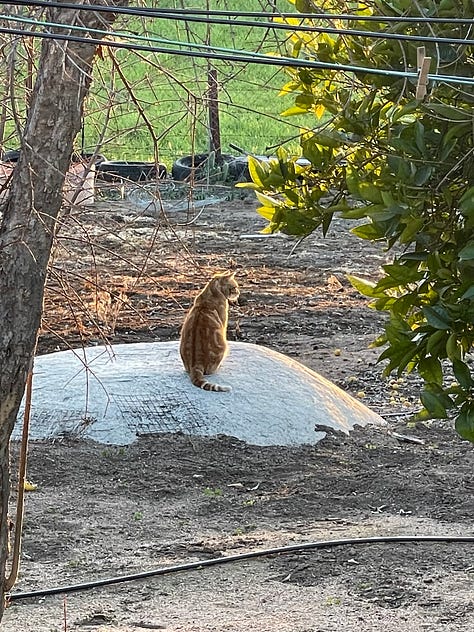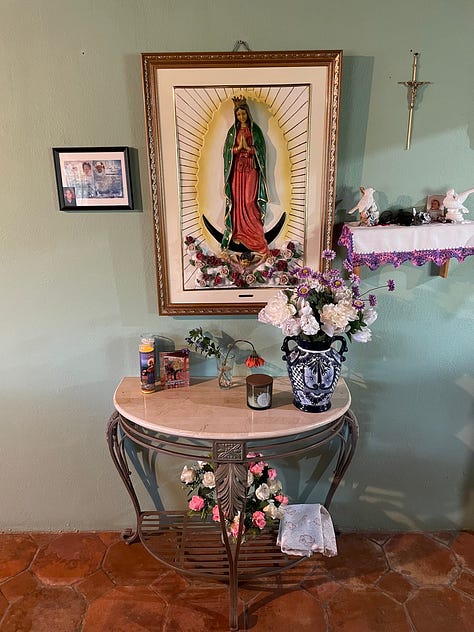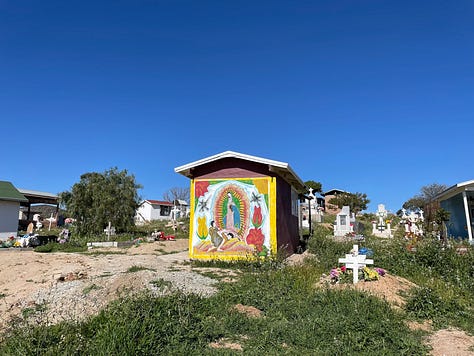A unique and urgent aesthetic
Valle de Guadalupe, Catholic damage & Margot Douaihy’s Scorched Grace
I spent the long holiday weekend at Nuvia’s grandfather’s rancho in Valle de Guadalupe in Baja California.
It’s a humble place without heat or air conditioning and all of the bedrooms have multiple beds to accommodate the many family members and their guests that pass through.
It’s also a special place where Nuvia spent countless weekends and summer breaks. It’s also where we got married more than fifteen years ago. I love it there.
We spent the weekend with Nuvia’s mother, her two tias, and a cousin who is like a third tia. They all love to cook, garden, and share meals together. They also love to talk—all at the same time. Every once in a while Nuvia would slip away while I was tending the fire and whisper, “They’re all talking and no one’s listening.” We brought a puzzle and some games and watched Vicente Fernandez movies on TV. An absolutely perfect weekend.



I also learned a new trick. I figured out that if I rave about a relatively simple meal that I ate in a restaurant the ladies will immediately show me how to make it. (I know better than to say someone else’s beans are the best I’ve ever tasted. I’m not trying to start a war here.) They do this to demonstrate 1) how simple it is and 2) how much better they can make it because cooking is their love language. Thus, I learned how to make potato soup so I can share the love.
Nuvia’s mother is a devout Catholic and her father’s house is full of religious iconography. I was struck by how often she or one her sisters would play a sermon or ceremony on YouTube.
At various times in my life I have been a devout Catholic, fervently ant-Catholic, and apathetically agnostic. The trappings of Catholicism are familiar to me but don’t move me much these days, but it wasn’t always this way.
I got my first taste of Catholicism when I was in the first grade. We moved from Virginia Beach where my dad was stationed on a ship to Northern Virginia where he was assigned shore duty in the Naval Annex in Washington, D.C. My parents sent me to the local public school where kids were sucking on lead pencils and eating paint chips. This freaked out my mom and I was promptly installed at St. James Catholic School in Falls Church, Virginia. (Someday I’m going to write a story set in False Church and I will burn in hell forever.)
St. James was my first exposure to priests and nuns and Sister Jean a.k.a. Sister Mean Jean Jellybean made an immediate impression on me. She was very tall and very stout and looked quite imposing in her dark veil and gown. I recall meeting her in the playground during recess and she seemed eleven feet tall. She towered over the kids the way Big Bird dwarfs the rest of the characters on Sesame Street. Sister Jean terrified me.
I went to St. James for eight years so I got to know nearly all of the nuns who taught at the school. I was also a paper boy for the Washington Post so I had a relationship with the nuns that the other kids at my school did not. Not only did I deliver the newspaper, but I had to collect the money as well, and collecting from the convent was always an ordeal. On the plus side, there was always someone home, but it took forever for them to answer the door. Then, they had to fetch the nun in charge of finances who would drag out one of those checkbooks that come in a great big binder. It took forever.



The nuns always brought me inside where it was either warm or cool depending on the season, but it was always dark and what little light there was came from candles. Most of the time they made me wait on a little bench by the front door, but sometimes they brought me inside to an office or the kitchen and I’d catch glimpses of the nuns in a more relaxed state. Peeling potatoes, doing laundry, etc. One time I saw a nun from school without her habit on and it was like seeing her naked.
On another occasion I saw a nun smoking a cigarette in the kitchen. It was the ’70s and smoking wasn’t such a big deal then. My mother smoked and for a project at school I made a collage depicting the Virgin Mary with cigarette ads I’d cut out of magazines. But I don’t entirely trust this memory after reading Margot Douaihy’s blistering new novel Scorched Grace, which features Sister Holiday, a tattooed nun with a gold tooth and a nicotine habit.
I spoke with Douaihy (and her publisher Gillian Flynn) about her new book for the Los Angeles Times and you should go and read that conversation now before going any further. I’ll wait.
It’s always a bit of a balancing act with these profiles. I don’t want to take up too much of the author’s time but I don’t want to wrap things up too quickly either. I’m always trying to get to a deeper level of questioning that elevates the profile into something that’s worth your time and mine. As a result, I invariably ask questions that don’t make it into the final piece.
Luckily for you, dear readers of Message from the Underworld, Douaihy spoke eloquently on a number of topics, particularly her faith, but also on the subject of her relationship to hardboiled fiction:
“I have a lifelong love of hardboiled fiction. I've always loved the slangy, lone wolf, virile private eye character and I've always been drawn to the hardboiled style of storytelling. So Walter Mosley, Raymond Chandler, Dashiell Hammett. Sometimes the shorter form stories like "Slippery Fingers" for Dashiell Hammett, but the other longer books with Chandler and Mosely I found them exceedingly poetic and sarcastic and infuriating. They're very problematized. They can be incredibly misogynistic, homophobic, racist, and xenophobic. They're also expertly written. They're beguiling in terms of their depth. They're lyrical. The characters know they're being annihilated. There's so much happening in those books and they encompass a lot of what I find interesting in character. So I've always had in mind to write a sleuth that was inspired by the whole hardboiled tradition. Wisecracking as armor, a defense against inner terror and vulnerability. I'm really a fan of characters that you can't quite predict where they're gonna go, but you're invested in them.”
Douaihy’s approach reminded me of Steph Cha’s Juniper Song series, which features a young Korean-American woman at the heart of her mysteries that subverts the problematic aspects of Raymond Chandler’s stories while staying true to the tropes.
“I studied mysteries and the craft of genre writing and mystery writing. This is the genre I turned to over and over again. I love the idea of something that's both fluid and stable. There are things that we like—I am speaking in a collective way—about the riddle, the puzzle, the whodunnit. There's something so interactive about mysteries, and it can also be a place of tremendous and profound poetry. And so I thought I'm just gonna go for it. I wanted to do something longer form and so it took a couple of years because I really just wanted to do it right. I wanted to do something fast-paced, but had moments of lyricism and mapped how people move through the world in unexpected ways. So it was just that lifelong love of the genre and a belief in the kind of books that I want to read, which are eccentric and weird and yet categorizable as a mystery.”
Our conversation kept twisting back to the symbols and signifiers of hardboiled storytelling, and how Douaihy incorporated them in her novel.
“There are also a lot of high camp signatures that fit within noir. Instead of a trench coat or Philip Marlowe's hat, she's got her gloves, her scarf, her cigarettes. I'm constantly trying to point back to the origins of what I love about shadowy tenebrous noir storytelling, and give it a twist. I also tried to include that in terms of the plot, the plotting twists, and just weaving in some of the temporal changes like going back in time, your origin stories… Storytelling that has heart and is bold and takes a big swing.”
I love the sub-genre of reluctant detective. Stories about gumshoes with their name on the door and a bottle of bourbon rolling around in the bottom drawer are fun to read but hard to swallow in 2023. I’m drawn to stories of off-kilter, reluctant detectives, people thrown into the fire, so to speak, but in Scorched Grace that’s literally the case.
Sister Holliday emerged from Douaihy’s desire to create a “sleuth within the feminist polemic” who was “a duty-bound person.” I was curious to know if Sister Holiday was pieced together as a composite or did she appear fully formed in Douaihy’s imagination?
“Sister Holiday definitely appeared fully formed. I had this image of her: from her fingernails to her jaw line, tattooed with religious iconography. Of course, Mother Superior makes Sister Holiday cover it up to be part of the group… I chose to do that as a character exercise so that people who catch a glimpse of her tattoos will think: Is she actually faithful? What does this actually mean? How can you be both? So that dialectic of someone who was into punk or who is proudly queer and takes a vow of celibacy and poverty in this modern era of social media and all the narcissism that goes with that. Visually, she's very, very clear in my mind. Always, I felt like I had to have that visual component as I drafted the book. Also, the way she speaks, the sardonic kind of self-sabotage that comes through in her language and her inner dialogue… So yeah, that’s a long way to answer the question about her emerging as a fully formed character.”
One of the biggest surprises for me is that Sister Holliday grew up in Bay Ridge, Brooklyn, which is where my mother grew up and several of my cousins live. It’s a place I visit often and if there’s any patch of New York I can claim to know even a little bit it’s Bay Ridge. I talked to Douaihy about how Sister Holiday reminded me of my cousin Noreen who is a die-hard progressive in a place that is getting increasingly conservative.
“I like people who are willing to fight and that's something I tried to write into Sister Holliday… She is kind of seeking justice or perhaps vengeance. Talk is cheap. People who are willing to scrap over something that they really believe in and can actually have a moment where we can say, “Let's hear each other out even if we maybe argue a little bit” is rare and beautiful and important.”
Lastly, we briefly touched on Douaihy’s love of punk rock and how that love informs Sister Holiday.
“When you double down on the uniqueness of a vision and an urgent aesthetic, that's what pierces through and what gets through to people. That's why I love different kinds of art. That's what I loved when I first heard punk music. Like when I first heard X-Ray Spex “Up Yours.” Oh, my God, the urgent, unique take on something is what brought me in. So the fact that a gold-toothed, tattooed nun, the specificity and eccentricity of her, is not going to be for everybody and I already know that.”
In my mind, Sister Holiday is not just a tattooed nun with a gold tooth but a tattooed nun with a gold tooth who looks like Sister Mean Jean Jellybean, who, as it turns out, wasn’t mean at all.
Postcards from a Dying World
Last week I neglected to mention that I was a guest on the podcast Postcards from the Dying World. The host, David, is a friend from San Diego so we touched on a number of aspects of SoCal literary life during the pandemic. This one isn’t just about Corporate Rock Sucks and touches on some of my previous books as well as my new book, Make It Stop. The conversation took place on Zoom so you can see my bearded face and a jacket that looks weirdly ill-fitting, which bothers me more than it should.
Milestone for Message from the Underworld
This week I welcomed my 1,000th subscriber to Message from the Underworld. On Tuesday morning D. Lisa West of Ojai, California, became subscriber number 1,000! To show my appreciation I will send her a copy of Corporate Rock Sucks. I also want to thank you (especially since you’re reading all the way to the very end) for supporting this project. Message from the Underworld is a weird blend of the personal of the professional with a bunch of opinions about books, music, and art thrown into the mix. I don’t take time off from the Message from the Underworld because I don’t see it as work or promotion or whatever. I just know that I love doing it. Thank you for being here.
What’s next? I’ve got a few more projects in the pipeline for the Los Angeles Times so you can expect more posts like today’s in the near future. My new novel comes out in April and I’ll have lots to say about that beginning next week, including some book tour news. I’m currently in Seattle and I’ll tell you all about that next week as well. Plus, the paperback version of Corporate Rock Suck comes out in June and I’ve got some cool stuff to share with you then.
Thanks again, please consider preordering Make It Stop, and see you next week…




Great interview! Really dug Margot's book. Loved the LAT piece with Gillian, too. And bonus: Sonic Youth. From an ex-Catholic schooler here...
Congrats on hitting 1000 readers!
There is a convent on the next block over, and the nuns that live there are mostly younger. A couple of them are avid runners, and it always seems odd to see them out on a run "in uniform."